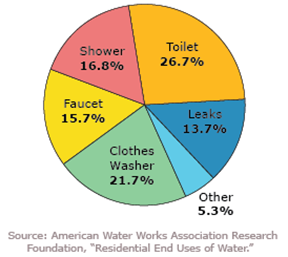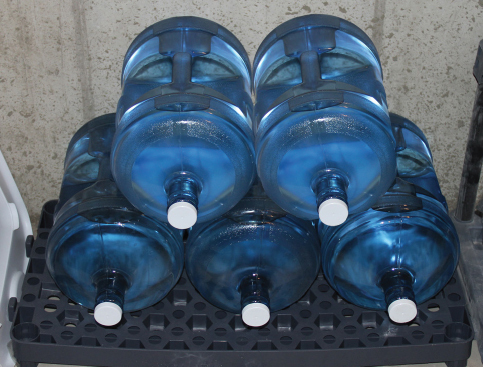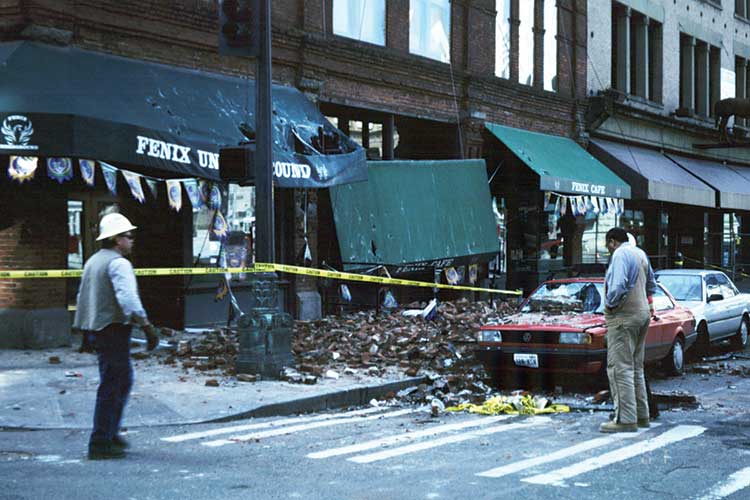Safe and reliable drinking water is something you may take for granted, until a disaster disrupts the water supply to your house. Here’s what North City Water District has done, and what we recommend YOU do, to be prepared in the event of an emergency.
Your Water District has been preparing for emergency events since we were officially formed back in 1931:
- Our reservoirs are oversized so that we can deliver water during peak demand times, such as a fire.
- Our water mains are oversized to allow for fire flow to go through the pipes to help fight fires.
- We have back-up generators installed where ever critical water and system monitoring equipment operates 24 x 7 x 365.
In addition to our strong system components, North City Water District recently joined a group of other regional utility providers including our regional provider, Seattle Public Utilities, in a training exercise that simulated a 9.0 level earthquake. The goal of this event was to help us test and confirm our mutual systems and procedures. We will continue to work closely with the other providers to strengthen intra-agency communications even more.
But we are only part of the equation. How will you and your family cope during the days after an emergency?
We recommend the following three simple steps. They only take about an hour to do, and will ensure you and your household is prepared in the event that a disaster causes an interruption in your water supply:
 Step 1: Know How Much Water You Need
Step 1: Know How Much Water You Need
Takes approximately 10-15 minutes
The first step in being prepared is knowing how much water to have on hand for emergencies. At a minimum, the American Red Cross recommends a gallon of water per day, per person, for at least three days. This will address the majority of basic water requirements — hydration, cooking, washing — however your household may require other uses of water that are less obvious.
Walk around your home with a notepad and jot down all the ways water is currently being used: house plants? the fish tank or an outdoor fish pond? your dog’s water dish? an outdoor greenhouse? Make a list of each use of water, and estimate approximately how much water is required, and how often, for each of the uses. Ask other family members to weigh in too.
Step 2: Think About Ways to Reduce Water Use
 Takes approximately 10-15 minutes
Takes approximately 10-15 minutes
Now that you have your list, think about which of the items on your list could be reduced or eliminated during an emergency—it’s almost like going camping.
Plates, cups and utensils could be replaced with disposable (preferably recyclable) paper and plastic to avoid having to wash dishes. Moving house plants outside to capture rainwater (during less cold months) could reduce their need for water. Using a local laundromat for washing clothes, if this facility has not been affected by the emergency, could be another option. Likewise an existing health club or gym membership, if the facility has not been affected, could be a convenient place to take showers. Make a note of each possibility on your list.
Step 3: Begin Maintaining a Back-Up Supply
Takes approximately 30 minutes
 Once you have determined the volume of water your household typically requires, it’s time to collect your own back-up water supply. Here are three tips from the City of Seattle’s Emergency Management department:
Once you have determined the volume of water your household typically requires, it’s time to collect your own back-up water supply. Here are three tips from the City of Seattle’s Emergency Management department:
Tip # 1: You can store water from the tap in plastic containers with a screw-cap lid, such as two-liter soda pop bottles or food-grade plastic jugs.
Thoroughly rinse out the container with water. For extra safety, thoroughly rinse the container with a weak solution of liquid chlorine bleach (8-10 drops in two cups water). Empty this solution out then fill the container to the top with fresh water.
Seal the container tightly, label it “drinking water” and
date it. Store it in a cool, dark place such as in a garage or basement, under the bed, or behind the sofa. Empty and refill every 6 months.
Tip # 2: You can purchase containers that are designed to store water at the grocery stores or camping supply stores. These come in various sizes of containers from single gallon to fifty-five gallon drums. Don’t forget to save extra water for your pets also.
Be sure these containers are food grade, BPA-free plastic and designed for water storage. Rinse and fill the same as in Tip # 1. Empty and refill every 6 months. Remember, the larger the container, the heavier and more difficult to pour the water from.
Tip # 3: Purchase cases of bottled water from the grocery or warehouse store. Label the case with the date and store in a cool, dark place. Replace bottled water prior to the expiration date on the bottles or at least once a year.
What to Avoid
- Do not use glass bottles (glass breaks too easily, particularly in an earthquake situation).
- Do not use old bleach bottles (or any container that has held a toxic substance). The plastic of old bleach bottles contains substances that, over time, get into the water and make it unfit for drinking. However bleach bottles are okay for storing water to flush a toilet, just be sure to mark these bottles very well to avoid confusion.
- Avoid the use of plastic milk jugs. They are difficult to seal tightly, and their plastic becomes very fragile and brittle over time.
- Do not use the water in your swimming pool or hot tub for drinking. If power is off, the pumps will likely be off too, which decreases filtration and water movement. However, pool and hot tub water can be an excellent source for flushing your toilet, rinsing off muddy boots or paws, and watering plants.
Other Helpful Water Storage Tips
- Cook without water whenever possible. The simple act of boiling potatoes can use up a lot of water which could be better used for drinking purposes.
- Large soup pots hold a lot of water for temporary drinking and washing purposes.
- Use your bathtub to store non-drinkable water: just pour a bucket of water into your toilet to manually flush it.
Additional Emergency Resources
National: www.ready.gov
City of Seattle: www.seattle.gov/emergency-management
City of Shoreline: www.shorelinewa.gov/emergency/emergency-management
City of Lake Forest Park: http://www.cityoflfp.com/index.aspx?NID=408

